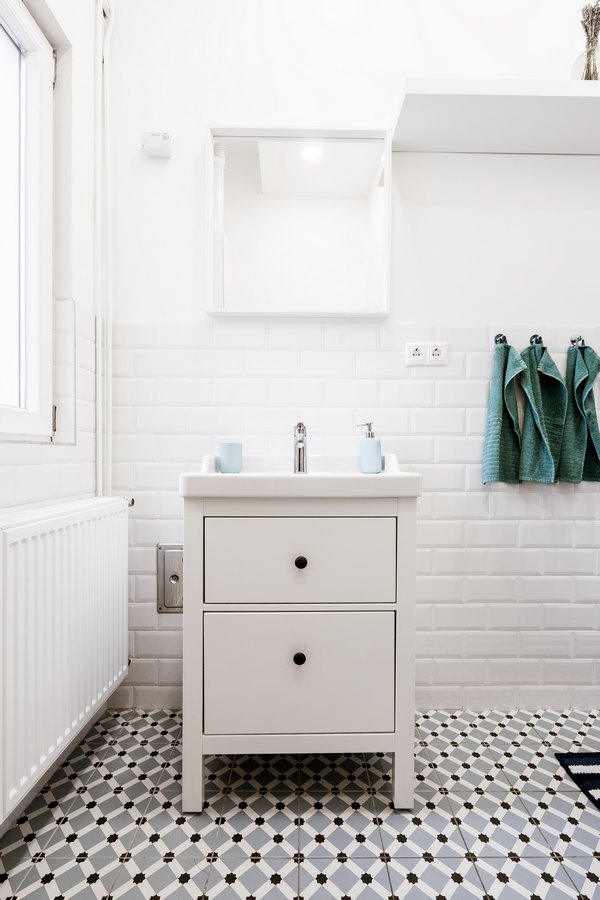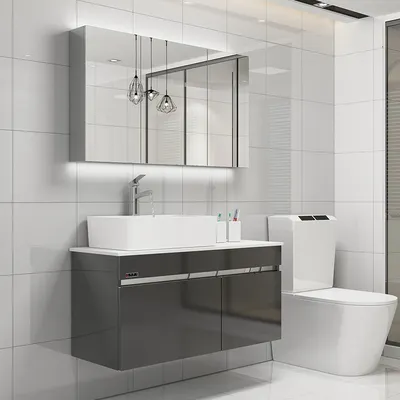If you're in the market for a new bathroom cabinet, it's important to choose the right material. Bathroom cabinets come in a variety of materials, including wood, metal, and plastic. Each has its own advantages and disadvantages. So what is the best material for a bathroom cabinet? Here's a look at the features of each type of material. In this blog post, we'll discuss the pros and cons of materials for bathroom cabinets, so that you can make an informed decision. We'll also provide tips on how to select the best material for your specific needs. So, whether you're considering wood or another material, read on for more information!
There are many different bathroom cabinet materials on the market to choose from. Some of the more common materials nowadays are wood, PVC and metal, so let's explore them one by one.
When it comes to bathroom cabinets, solid wood is often seen as the superior material. The solid wood material is made from natural wood as the main substrate. It is treated with environmentally friendly paint spraying to improve water resistance.
![]() Pros:
Pros:
Solid wood looks more generous and natural. It does not discolour easily. And it is high-grade, elegant and upscale.
Compared to other man-made panels, solid wood cabinets are more natural and environmentally friendly as they have lower formaldehyde emissions and are also stronger and more durable.
Solid wood is also a very good insulator, so your bathroom will stay warmer in winter and cooler in summer.
![]() Cons:
Cons:
Solid wood cabinets are typically more expensive than other types of cabinets, requiring more care and maintenance. They are also susceptible to moisture damage, so it's important to make sure they are properly sealed. And over time, it is easy to crack, especially in the north.
If you pay more attention to the texture of the bathroom cabinet, then solid wood is the best material choice for bathroom cabinets.
Though solid wood construction has generally been considered the gold standard for bathroom cabinetry, plywood is increasingly being used as an alternative material. As with any building material, there are both advantages and disadvantages to using plywood in bathroom cabinetry.
![]() Pros:
Pros:
Plywood brings an overall feel similar to solid wood, with natural elegance.
One key advantage of plywood is that it is very dimensionally stable, meaning it is less likely to warp or bow over time than solid wood. This makes it an ideal choice for use in areas with high humidity, such as bathrooms. Plywood is also generally more resistant to water damage than solid wood, making it a good choice for cabinet doors that may be exposed to splashes of water.
![]() Cons:
Cons:
On the downside, plywood is not as strong as solid wood, so it may not be the best choice for areas that receive a lot of heavy traffic. Additionally, because it is made from several layers of thin veneer, it can be more difficult to repair than solid wood if it sustains damage. Overall, plywood bathroom cabinets offer both advantages and disadvantages that should be considered before making a final decision.
If you don't have that much budget and want to get the same textured look as a solid wood bathroom cabinet, then plywood is the best material choice for bathroom cabinets!
PVC is a type of plastic and is one of the more popular and widely used synthetic materials today.
![]() Pros:
Pros:
Bathroom cabinets made from PVC materials are the first choice for young friends because of their rich and vibrant colours, varied styles and fashionable and avant-garde squares. This material is brightly coloured, corrosion-resistant, lightweight and durable.
It is also resistant to high temperatures, anti-scratching and easy to clean. PVC sheets are waterproof and have an advantage in terms of price.
![]() Cons:
Cons:
PVC is not very resistant to chemicals. PVC material is easy to fade, and the fading PVC bathroom cabinets will be greatly reduced in appearance. Another important thing is that PVC bathroom cabinets are easily deformed.
If your requirements for bathroom cabinets are not too high, then PVC is the best material choice for bathroom cabinets.

Made from high-quality stainless steel sheets and other materials, processed by cutting, bending and polishing processes.
![]() Pros:
Pros:
Good stainless steel bathroom cabinet with good waterproof performance. This material is durable. They are environmentally friendly, moisture-proof, mould-proof and rust-proof. In addition to this, they come in a variety of styles and chic designs.
![]() Cons:
Cons:
The hardness of stainless steel is only 2MM, which is limited by the material, and the bathroom cabinets made of it are a bit thin, not as heavy as solid wood bathroom cabinets. So they are not very practical. It is also easy to leave traces of soap and shampoo. Stainless steel tends to darken and lose its original lustre.
If you are more concerned about the value for money of your bathroom cabinet, then stainless steel is the best material choice for bathroom cabinets.

Aluminium alloy bathroom cabinets are made of aluminium and other lightweight metal and are available in a variety of styles.
![]() Pros:
Pros:
The surface of aluminium alloy bathroom cabinet is smooth, bright and clean, and has a strong metallic luster. It is also very easy to wipe and clean. The use of aluminium alloy bathroom cabinets gives people a bright visual experience and creates a clean and tidy bathroom environment.
They are durable and low maintenance, which means they will last a long time with minimal care. They are also lightweight, making them easy to install. In addition, aluminum alloy is a good conductor of heat, so it helps to keep the cabinet contents cooler.
![]() Cons:
Cons:
However, there are some disadvantages to using aluminum alloy bathroom cabinets. They can be expensive, and they are not as sturdy as other materials such as wood or metal. In addition, aluminum alloy is a poor insulator, so it is not ideal for use in humid environments.
If you are more concerned about the durability of your bathroom cabinet, then aluminium is the best material choice for bathroom cabinets.
Materials | Pros | Cons | Application |
Solid Wood |
|
|
|
Plywood |
|
|
|
PVC |
|
|
|
Stainless Steel |
|
|
|
Aluminium Alloy |
|
|
|
Each bathroom cabinet material has its own features, but they all require regular maintenance to ensure they last longer.

Conclusion paragraph: In conclusion, there are a few different materials that can be used to make bathroom cabinets. The most popular options include solid wood, plywood, PVC and stainless steel. Each material has its own set of pros and cons, so it is important to consider these before making a purchase. Additionally, it is essential to remember to clean and maintain the cabinet regularly in order to keep it looking new for as long as possible. If you’re interested in getting a custom-made bathroom cabinet, come and see us at our showroom – we would be more than happy to help you find the perfect product for your needs.
Copyright 2022 - All Mirplusbath